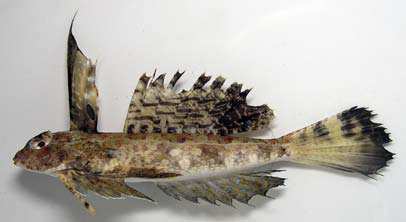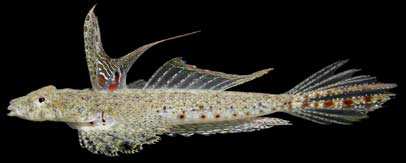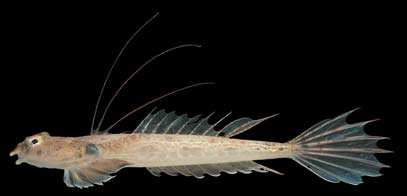CALLIONYMIDAE
Dragonets
By Koichi Shibukawa
 Dactylopus dactylopus |
 Paradiplogrammus enneactis |
 Repomucenus schaapii |
|
Small to moderate-sized (up to 45 cm), depressed benthic fishes. Body elongate, depressed or subcylindrical. Head usually wide and well depressed, triangular when seen from above in many species; gill opening restricted to a small dorsal or sublateral pore; preopercle with a strong spine; no spines on opercle and subopercle; jaw with villiform teeth; no teeth on roof of mouth; upper jaw greatly protractile. Two dorsal fins, comprising spinous (with III-V spines; rarely absent) and soft (with 7-10 soft rays) portions; anal fin with 6-10 soft rays; pelvic fins thoracic, with I spine and 5 soft rays. No scales on head and body. Color: highly variable, but dull sandy-colored in many species, e.g., head and body grayish or brownish dorsally, whitish ventrally, mottled and/or spotted with paler colored spots; some have entirely reddish body (especially in deep-water species) or several vivid color with complex patterns on head, body and fins. Similar families occurring in the area. Eleotridae: usually no preopercular spine; gill opening wide; scales on body. Gobiidae: usually no preopercular spine; pelvic fins fused medially one another in many species; gill opening wide. Platycephalidae: mouth large, lower jaw projecting beyond upper jaw; short spines, serrae and/or bony tubercles on the head; gill opening wide; scales on body. Remarks. Found in seagrass beds, bays, coral reefs, estuaries, and shelf waters, and commonly found on sandy or muddy bottoms. Locally utilized as food fish. |

|
|